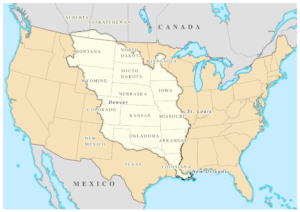Good morning, Whitewater.
Thursday in town will be cloudy in the morning, with afternoon sunshine, and a high of fifty-seven. Sunrise is 7:15 AM and sunset 6:02 PM, for 10h 47m 08s of daytime. The moon is a waning gibbous with 75.2% of its visible disk illuminated.
On this day in 1803, the United States Senate ratified the Louisiana Purchase treaty:
By William Morris – CC BY-SA 4.0, Link
The Louisiana Purchase (French: Vente de la Louisiane “Sale of Louisiana”) was the acquisition of the Louisiana territory (828,000 square miles) by the United States from France in 1803. The U.S. paid fifty million francs ($11,250,000 USD) and a cancellation of debts worth eighteen million francs ($3,750,000 USD) for a total of sixty-eight million francs ($15,000,000 USD, or around a quarter of a billion in 2016 dollars). The Louisiana territory included land from fifteen present U.S. states and two Canadian provinces. The territory contained land that forms Arkansas, Missouri, Iowa, Oklahoma, Kansas, and Nebraska; the portion of Minnesota west of the Mississippi River; a large portion of North Dakota; a large portion of South Dakota; the northeastern section of New Mexico; the northern portion of Texas; the area of Montana, Wyoming, and Colorado east of the Continental Divide; Louisiana west of the Mississippi River (plus New Orleans); and small portions of land within the present Canadian provinces of Alberta and Saskatchewan. Its population was around 60,000 inhabitants, of whom half were African slaves.[1]
The Kingdom of France controlled the Louisiana territory from 1699 until it was ceded to Spain in 1762. Napoleon in 1800, hoping to re-establish an empire in North America, regained ownership of Louisiana. However, France’s failure to put down the revolt in Saint-Domingue, coupled with the prospect of renewed warfare with the United Kingdom, prompted Napoleon to sell Louisiana to the United States. The Americans originally sought to purchase only the port city of New Orleans and its adjacent coastal lands, but quickly accepted the bargain. The Louisiana Purchase occurred during the term of the third President of the United States, Thomas Jefferson. Before the purchase was finalized, the decision faced Federalist Party opposition; they argued that it was unconstitutional to acquire any territory. Jefferson agreed that the U.S. Constitution did not contain explicit provisions for acquiring territory, but he asserted that his constitutional power to negotiate treaties was sufficient….
The United States Senate ratified the treaty with a vote of twenty-four to seven on October 20. The Senators who voted against the treaty were: Simeon Olcott and William Plumer of New Hampshire, William Wells and Samuel White of Delaware, James Hillhouse and Uriah Tracy of Connecticut, and Timothy Pickering of Massachusetts.
On the following day, October 21, 1803, the Senate authorized Jefferson to take possession of the territory and establish a temporary military government. In legislation enacted on October 31, Congress made temporary provisions for local civil government to continue as it had under French and Spanish rule and authorized the President to use military forces to maintain order. Plans were also set forth for several missions to explore and chart the territory, the most famous being the Lewis and Clark Expedition.
On this day in 1856, Frederick Douglass speaks in Beaver Dam:
On this date Frederick Douglass arrived in Beaver Dam and spoke about the brutality and immorality of slavery. His speech was also intended to generate support for the abolitionist movement in Dodge Co. and Wisconsin. A former runaway slave and leading orator and author of the abolitionist movement, Douglass is regarded as one of the most influential Americans of the 19th century. [Source: Wisconsin Local History Network]
On 10.20.1982, the Brewers win the World Series in seven games:
On this date the Milwaukee Brewers played game seven against the St. Louis Cardinals in the “Suds Series” to be crowned Major League Baseball World Champions. The Cardinals won the series 4 games to 3 to be named World Champs. [Source: Baseball Almanac]

